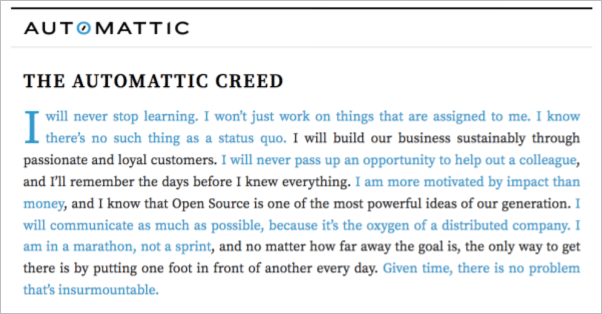Help candidates self-select with a unique company mission
Stories Inc. co-founder Scott Thompson explains why non-cookie-cutter mission statements and culture content help candidates self-select into or out of your unique company mission.
I heard a podcast interview with Matt Mullenweg, CEO of Automattic and creator of WordPress, and I loved his take on company mission statements.
“When I read visions or missions, there’s usually nothing that another company wouldn’t agree with,” Mullenweg says in the interview.
A mission that not everyone agrees with
Mullenweg talks about how some of the more spirited internal conversations at Automattic come about when they want to add something to the company’s mission. They ask themselves, “what’s the thing we could say that not every other company would say?”

Automattic’s creed, above, includes lines like, ‘Open source is the most powerful idea of my generation’ and ‘I’m more motivated by impact than money.’
“Those are two fairly controversial ideas,” Mullenweg says. “I don’t think everyone would agree with it, and that’s great, because I don’t want to employ everyone. I want to employ only the people who are excited when they hear that sentence.”
Content that doesn’t resonate with everyone
A similar philosophy has been the backbone of our methodology at Stories Inc. for many years. We try to uncover stories that—when pieced together in a content library—paint a truly unique picture of that company. What does it look like to live the mission at the company? What happens at the company that wouldn’t happen anywhere else?
In fact, our most successful client content libraries are ones that don’t resonate with all candidates. After consuming the content, some folks just may not feel a connection to the mission or culture and so they aren’t the best people to help the company in pursuit of its mission. By helping people self-select out of the application process, the company prevents issues (e.g., low engagement, low morale, turnover) that could become fatal to the company down the road.
Meanwhile, the people that digest the company’s content and feel the pull of the company’s mission and believe they’d thrive in the culture — those are the people the company should want more of. They’ll be more engaged and productive team members and will be better brand ambassadors in attracting equally mission-aligned people.
The takeaway: no need to please everyone
Following Mullenweg’s example will go a long way. When revisiting your company’s mission, think about what your company believes at its core that not all companies would agree with.
And when creating content about your mission and culture, use true stories that paint a really vivid picture — even if that picture wouldn’t resonate with everyone.
In short, when it comes to your mission and mission-related content, don’t feel like you have to please everyone. Sure, you’ll turn away some people, but that’s okay. They’re not the ones who will help you achieve your mission. The people that do feel a connection to the mission are the ones you want joining the cause.
More by Scott Thompson
Align with mission for your employer brand
Skin in the game: reduce risks, align incentives
When human values and organizational values overlap
Learn more about communicating culure to candidates—quickly!—in our guide.
Image courtesy Tim Green via Flickr Creative Commons

